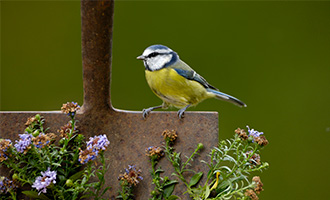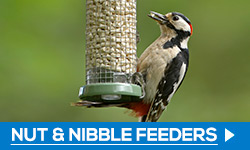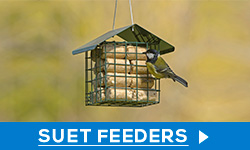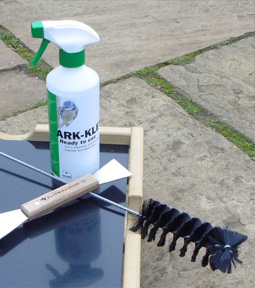Bird feeders buying guide
Feeding your wild garden birds is great fun for all the family. We put together this handy feeder guide to help you choose the right bird feeders for your bird food and birds.
Choosing the right feeder

Every bird is different, not only in size but also in their preferences for food and feeder. Some are happy to come out to the open to feed, while others prefer to stay in or close to cover.
TIP: By providing a variety of feeding sites, you can attract a wider range of birds into your garden.
There are many different styles and designs of feeders available. Depending on what type of birds you would like to feed in your garden, you can choose between a range of feeders.
However, the most important factor to consider is bird safety. Is the feeder safe for birds to use? With no points where birds’ feet could get trapped? What bird seed do you need for your bird feeder? And, if you have squirrels or cats in your garden, what is the best feeder to keep your bird food and birds safe? All RSPB bird feeders are designed with bird safety in mind. Read on to learn more about the different options available.
Seed feeders
You want to make sure every bird in your garden - from small birds like Robins and Blue Tits to larger birds like Woodpeckers and Blackbirds - gets the right kind of energy-rich bird food they need.
A seed feeder can attract many different species to your garden, including sparrows, tits, finches and Siskins.
Available with plastic or metal fittings, they come in a wide variety of sizes and styles and are suitable for sunflower seeds, sunflower hearts or any free-flowing feeder seed mix.
TIP: Metal fittings usually last longer than plastic and they are more resistant to squirrel damage. Look for RSPB Ultimate feeders.
For nyjer seed you need a specially designed feeder as this seed is smaller than other bird food. These special feeders have very small holes or slits instead of the standard feeding ports, which helps prevent too much seed from being wasted.
For even less waste you can add a seed tray to your seed feeders. It catches dropped seed and provides extra perching space. Be aware though, that if you wish to attract smaller birds, seed trays are an inviting place for larger birds.
Suet pellet & peanut feeders
Ideal for suet pellets and peanuts, suet pellet and peanut feeders are often popular with tits, Woodpeckers, Nuthatches and other species that cling.
The only safe method of offering peanuts to wild birds are feeders made from steel mesh. The mesh size needs to be large enough to prevent beak damage and small enough to prevent large pieces of nut from being removed – about 6 mm is a good compromise.
These feeders can also be used to feed suet pellets, which are a great alternative to peanuts.
Suet feeders
Suet feeders come in many shapes and sizes. Some are suitable for suet balls, others for suet cakes. Some are multi-purpose and can be used for either balls or cakes.
Generally these feeders are made from a wide metal mesh, which holds the suet and provides birds with something to cling to while feeding.
Suet feeders are particularly popular with members of the tit family and starlings.
Predators
Grey Squirrels
Grey Squirrels can be a real problem when feeding your garden birds. They can damage your feeders by chewing through plastic rapidly, rendering them useless.
Squirrels also have a large appetite, and will make short work of the bird food you put out, if they can get to it. A guardian around your feeder can help to deter squirrels (however, in order to make the food accessible to birds, it’s not possible to make anything fully squirrel ‘proof’). Small or juvenile squirrels are able to squeeze through even quite narrow gaps.
Placing your feeders at least 2 metres away from any jumping-off point, such as a tree, shrub or fence will help to keep them at a distance, but they can jump up from the ground, or down from above.
Placing squirrel cones above and/or below your feeders can help stop the squirrels reaching them.
Cats
Another kind of problematic visitors to your garden are cats. Unlike birds of prey, domestic cats are not natural predators anymore. They do not need to hunt to survive, and their habit of catching birds, particularly during the breeding season, can be a problem for all types of birds.
There are many deterrents on the market, that can be used with varying degrees of success, to create a cat-free zone in your garden. We have tested and approved the Catwatch deterrent. When the sensor inside detects movement it emits a high-pitched sound disliked by most cats (but inaudible to humans). The frequency emitted is unique to cats hearing range, so the Catwatch won't bother other garden wildlife, such as hedgehogs.
You can help protect birds from cats while feeding by using guardians on your feeders and taking steps to prevent cats from climbing trees. This gives the birds a safe haven, where they can feed and perch out of immediate danger. Similar to squirrels, make sure you place your feeders away from dense cover and places where cats can lie in wait. Keeping a clear area around your feeders should help the birds stay out of pouncing distance.
Hygiene is important!
Whatever you feed birds with, good hygiene around feeders and bird baths is important all year round, but particularly so during the summer months. The warm weather can make bird food go off more quickly, and can provide ideal conditions for harmful bacteria to proliferate.
Salmonella is present at a low level in wild bird populations, and poor hygiene at feeding stations can fuel a local outbreak. Greenfinches and house sparrows are most susceptible to this infection, which is transmitted by droppings from an infected bird.
It’s important to clean feeders regularly, and to always exercise sensible hygienic care: clean the feeders outdoors, keep separate brushes for the purpose, wear gloves and wash hands after finishing the job.


